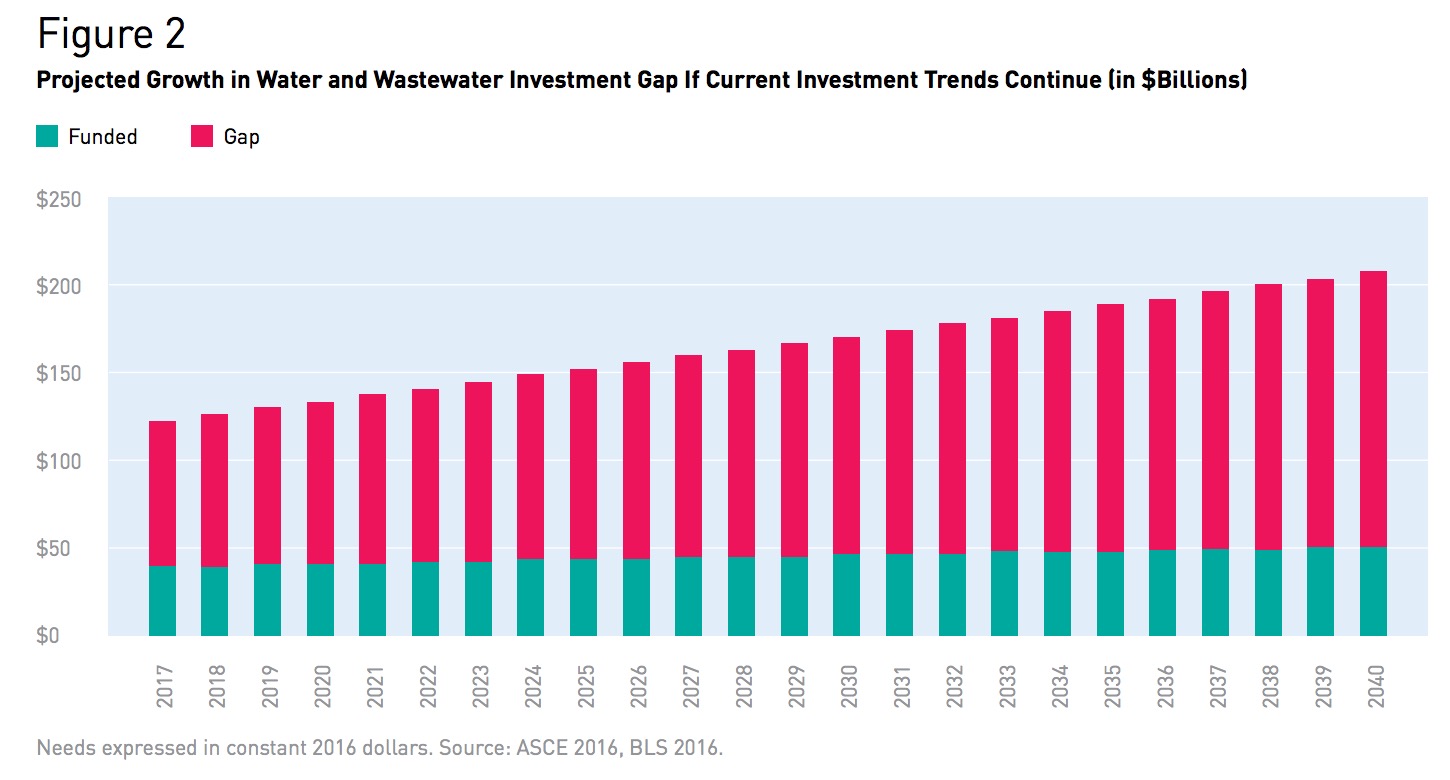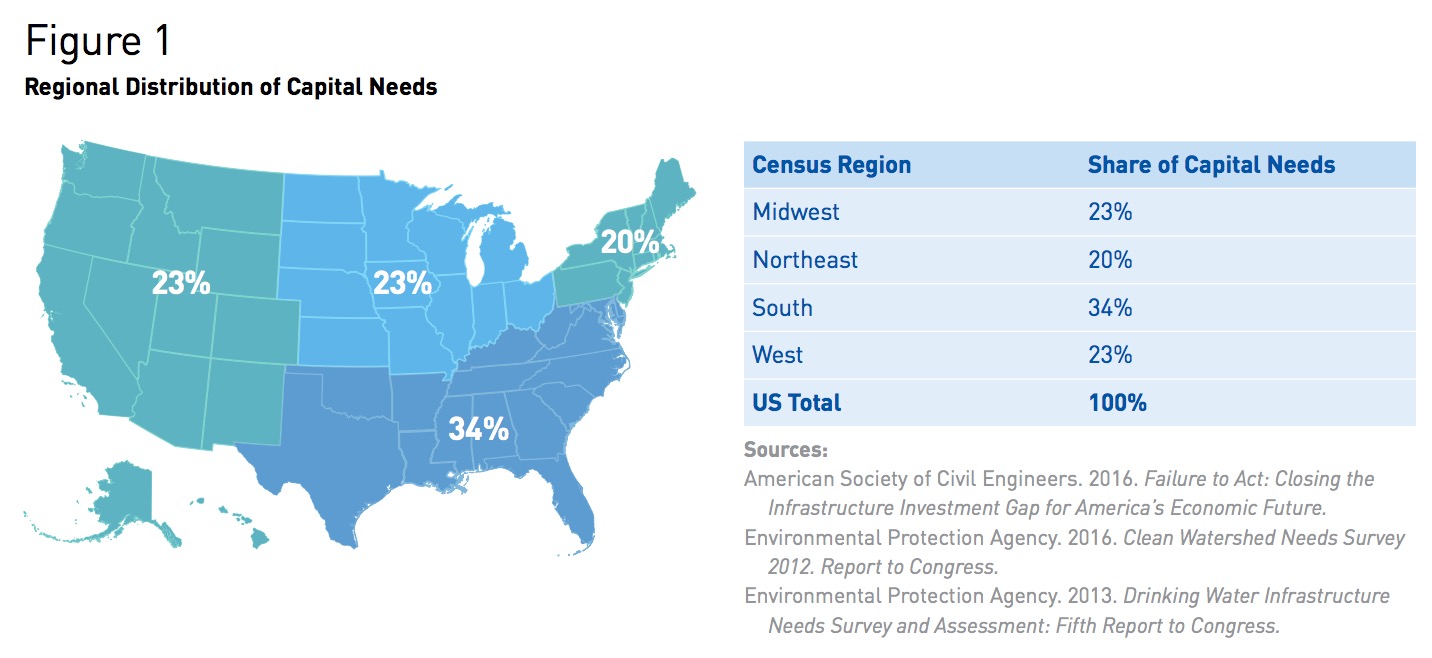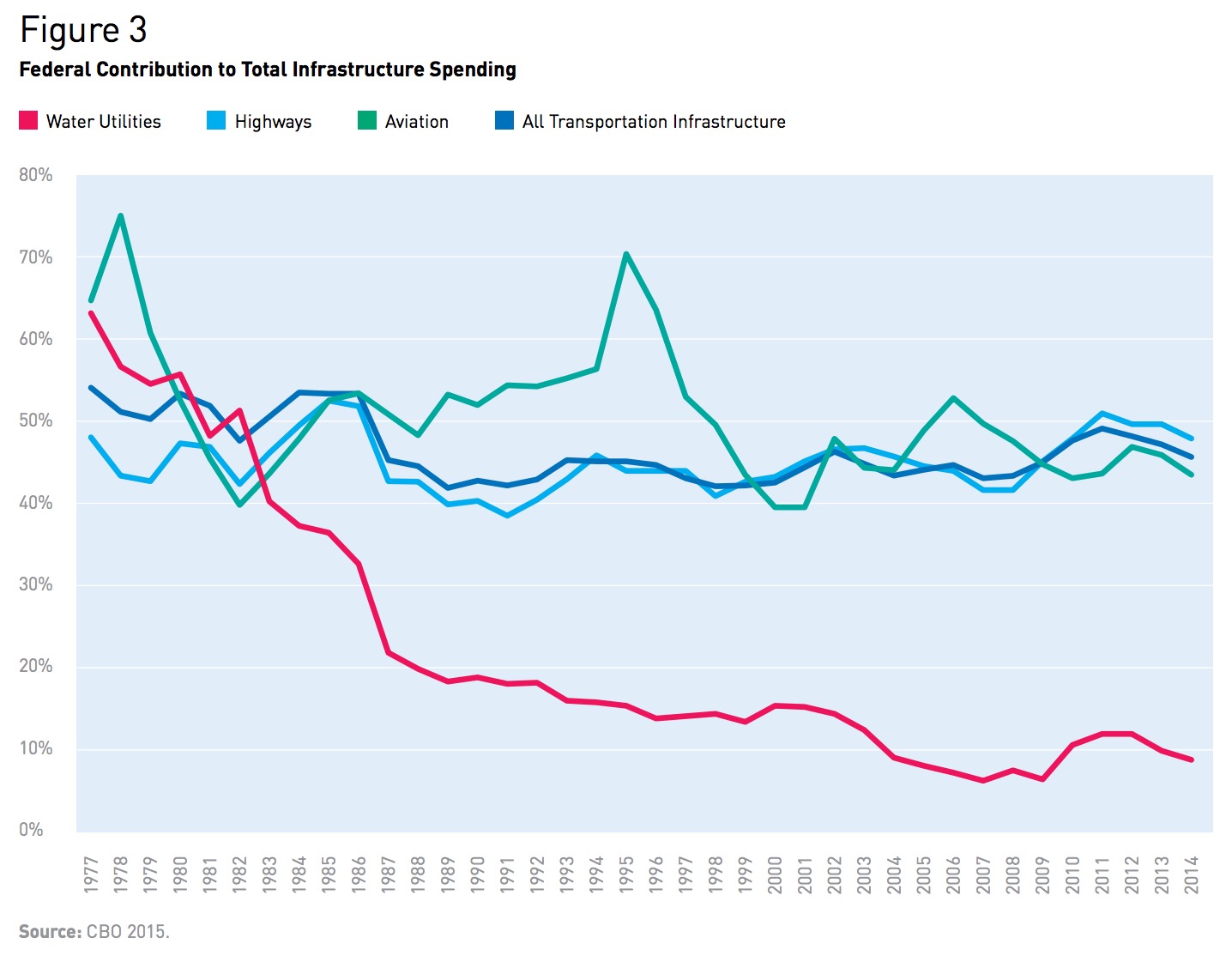VALUE OF WATER CAMPAIGN
Purpose of the Report
The Value of Water Campaign commissioned an economic impact analysis to understand how increasing investments in the nation’s water infrastructure can affect economic growth and employment. The study reviews the projected capital needs of water, wastewater, and stormwater utilities, and estimates the associated economic benefits that would be realized if the nation chose to make these investments. These benefits include the economic opportunities created by water infrastructure projects, the long-term productivity savings to the customers of water utilities, as well as the avoided costs of frequent disruptions in water and wastewater service to business. Because many sectors are reliant on water, a disruption of water and wastewater service, even for one day, can cost businesses significant amounts of revenue and almost instantly shrink the annual national Gross Domestic Product (GDP).
The analysis builds on a previous report, “National Economic and Labor Impacts of the Water Utility Sector,” published by the Water Research Foundation and the Water Environment Research Foundation, which evaluates the economic contributions of 30 of the nation’s largest water and wastewater utilities serving 25 percent of the nation’s population.
Introduction
Water is essential to all aspects of life. Water sustains families and communities. It supports economic productivity. From semiconductor manufacturing, to agriculture, to hotels and restaurants, virtually all sectors of the economy rely on water.
In this report, the term “water infrastructure” is used to encompass the structures and facilities that are operated by water, wastewater, and stormwater utilities, both public and investor-owned. These may include important infrastructure assets such as pipes, pumps, treatment plants, and more. In the US, approximately 52,000 water systems deliver drinking water to homes and businesses and approximately 16,000 centralized treatment plants collect and treat wastewater so it can be recycled or returned to the environment (EPA 2016b, Shifrin 2014). Many wastewater utilities also manage stormwater either through combined systems that handle both stormwater and wastewater, or separate stormwater systems. While publicly-owned utilities serve most homes and businesses, investor-owned utilities also play an important role, directly serving 50 million Americans and making up 15 percent of the US municipal water sector based on population served (Bluefield Research 2016).
Many of the nation’s water and wastewater systems have been in operation for a century or more. As pipes, pumps, and plants reach the end of their expected lifespan, water infrastructure capital needs are growing rapidly, yet investment in water infrastructure is not keeping pace. Based on a 2016 assessment by the American Society of Civil Engineers (ASCE), this study estimates that the US needs to invest an additional $82 billion per year in water infrastructure at all levels of government over the next 10 years to meet projected capital needs.
If the estimated investment gap were closed, it would result in over $220 billion in total annual economic activity to the country. These investments would generate and sustain approximately 1.3 million jobs over the 10- year period.
Furthermore, the value of safe provision, delivery, and treatment of water to customers results in significant avoided costs for businesses that would otherwise have to provide their own water supplies. These investments would save US businesses approximately $94 billion a year in sales in the next 10 years and as much as $402 billion a year from 2027 to 2040.
Current national capital need: $123 billion per year
Water utilities serve 86 percent of the national population and provide approximately half of the freshwater used by commercial and industrial businesses (USGS 2014). On a daily basis, water utilities distribute 42 billion gallons of clean water (USGS 2014). Wastewater utilities serve 75 percent of the population while collecting and treating 32 billion gallons of wastewater daily (Shifrin 2014). Providing this scale of service requires significant ongoing capital investment to repair or replace the distribution lines, conveyance systems, treatment plants, and storage tanks that keep water, wastewater, and stormwater systems working.
Currently, capital needs of water, wastewater, and stormwater utilities are on the rise as infrastructure built decades ago nears the end of its useful life. Based on ASCE’s estimates of water infrastructure needs (ASCE 2016), the US needs to invest a minimum of $123 billion per year in water infrastructure over the next 10 years (in current 2016 dollars) to achieve a good state of repair.
Projected capital needs are distributed throughout the nation with 23 percent of needs reported in the Midwest, 20 percent in the Northeast, 23 percent in the West and 34 percent in the South (see Figure 1). Note that capital needs presented in this report represent the minimum investment required to bring water, wastewater, and stormwater systems to a state of good repair. They do not account for costs associated with adding capacity in high-growth regions, responding to natural disasters, or developing new sources of water.
Investment needs grow as water infrastructure reaches the end of its lifespan
The reason for the surge in nationwide replacement needs can be explained by the timing, lifespan, and design of investments in water infrastructure over the last century. With a lifespan of 75 to 100 years, much of the nation’s underground pipes are due for replacement. Based on analysis by the American Water Works Association (2011), approximately one-third of water mains nationwide will require replacement by 2040. As an indication of mounting needs, water mains currently experience an estimated 240,000 breaks per year (ASCE 2013). Wastewater systems face distinct, but equally pressing challenges. Many wastewater systems built in the first half of the twentieth century were designed to collect stormwater and wastewater as part of a single, combined system. During storm conditions, combined systems can overflow, causing untreated wastewater and stormwater to enter waterways. Every year, 900 billion gallons of untreated wastewater and stormwater are released to water bodies without being treated (Galavotti 2015). As a result of greater frequency and intensity of storm events in many communities, combined sewer systems have become even more susceptible to overflows.
National investment gap: $82 billion per year
Aggregate capital spending on water infrastructure at the local, state, and federal level currently totals $41 billion per year—significantly below the minimum annual need. Without additional investment, only one-third of capital needs will be funded over the next ten years, representing an annual funding gap of $82 billion per year. If current needs are left unaddressed, the annual gap is projected to rise to $109 billion by 2026 and $153 billion by 2040, as needs from prior years accumulate (see Figure 2).

The decline in federal investment
Meeting the water infrastructure gap requires greater investment at the local, state, and federal levels. The federal government was instrumental in the development of water infrastructure over the previous century. As the country assesses its 21st century water infrastructure demands, there is a need for meaningful federal investment.
Despite rising capital needs, the federal government’s contribution to water infrastructure capital spending has fallen over the past 30 years from 63 percent of total capital spending in 1977 to nine percent of total capital spending in 2014. In terms of per capita spending on water infrastructure, federal spending has fallen from $76 per person in 1977 to $11 per person in 2014 (2014 dollars; CBO 2015). In contrast, over the same time period, the federal government’s share of total public spending on transportation infrastructure (including highways, mass transit, and aviation) has stayed constant at approximately half of total capital spending, with the remainder coming from state and local sources (see Figure 3) (CBO 2015).
Today, the federal government dedicates far fewer resources to water infrastructure than it spends on a broad range of priorities, from research and development, to highways, to grants for higher education (see Figure 4). For example, the federal government spends approximately 24 times more upgrading and maintaining the information technology (IT) infrastructure of federal agencies than it does repairing the nation’s water systems.
As federal support for water infrastructure has declined, local and state spending has increased to help meet capital needs. Per capita spending by local communities has more than doubled in real terms from $45 in 1977 to upwards of $100 per person in 2014 (2014 dollars). Despite increased contributions from water ratepayers, this report shows that funding for water infrastructure continues to fall far below capital needs. The following sections of this report highlight the economic benefits that can be achieved if all levels of government, along with the private sector, work together to close the funding gap.
Download full version (PDF): The Economic Benefits of Investing in Water Infrastructure
About the Value of Water Campaign
thevalueofwater.org
The Value of Water Campaign educates and inspires the nation about how water is essential, invaluable, and in need of investment. Spearheaded by top leaders in the water industry, and coordinated by the US Water Alliance, the Value of Water Campaign is building public and political will for investment in America’s water and wastewater infrastructure through best-in-class communications tools, high-impact events, media activities, and robust research and publications.
Tags: Federal Funding, Value of Water, Value of Water Campaign, Water








 RSS Feed
RSS Feed